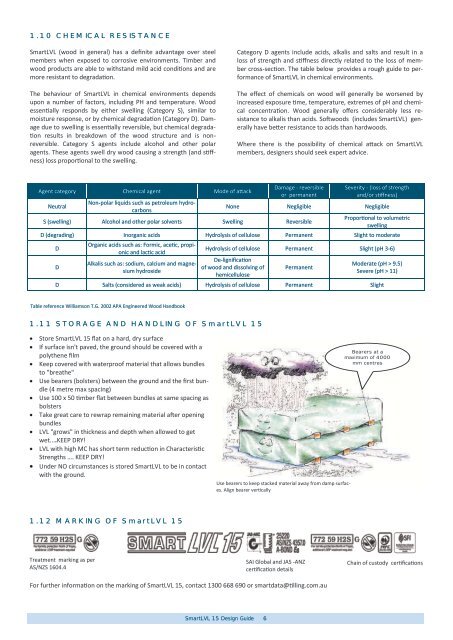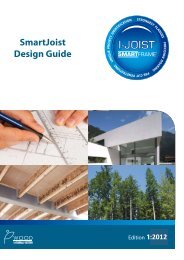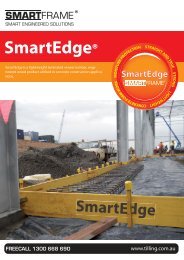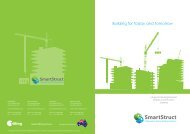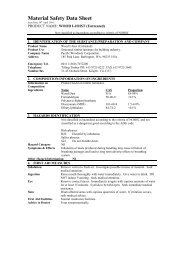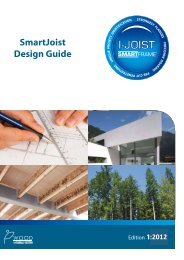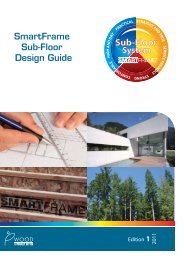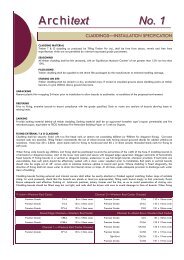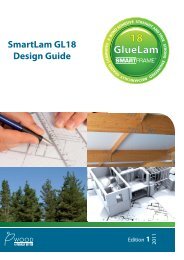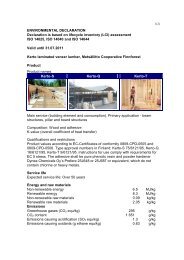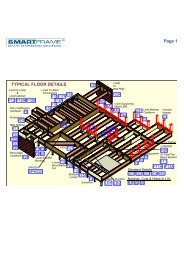SmartLVL 15 Design Guide - Tilling Timber
SmartLVL 15 Design Guide - Tilling Timber
SmartLVL 15 Design Guide - Tilling Timber
You also want an ePaper? Increase the reach of your titles
YUMPU automatically turns print PDFs into web optimized ePapers that Google loves.
1.10 CHEMICAL RESISTANCE<strong>SmartLVL</strong> (wood in general) has a definite advantage over steelmembers when exposed to corrosive environments. <strong>Timber</strong> andwood products are able to withstand mild acid conditions and aremore resistant to degradation.The behaviour of <strong>SmartLVL</strong> in chemical environments dependsupon a number of factors, including PH and temperature. Woodessentially responds by either swelling (Category S), similar tomoisture response, or by chemical degradation (Category D). Damagedue to swelling is essentially reversible, but chemical degradationresults in breakdown of the wood structure and is nonreversible.Category S agents include alcohol and other polaragents. These agents swell dry wood causing a strength (and stiffness)loss proportional to the swelling.Category D agents include acids, alkalis and salts and result in aloss of strength and stiffness directly related to the loss of membercross-section. The table below provides a rough guide to performanceof <strong>SmartLVL</strong> in chemical environments.The effect of chemicals on wood will generally be worsened byincreased exposure time, temperature, extremes of pH and chemicalconcentration. Wood generally offers considerably less resistanceto alkalis than acids. Softwoods (includes <strong>SmartLVL</strong>) generallyhave better resistance to acids than hardwoods.Where there is the possibility of chemical attack on <strong>SmartLVL</strong>members, designers should seek expert advice.Agent category Chemical agent Mode of attackNeutralNon-polar liquids such as petroleum hydrocarbonsDamage - reversibleor permanentSeverity - (loss of strengthand/or stiffness)None Negligible NegligibleS (swelling) Alcohol and other polar solvents Swelling ReversibleProportional to volumetricswellingD (degrading) Inorganic acids Hydrolysis of cellulose Permanent Slight to moderateDDOrganic acids such as: Formic, acetic, propionicand lactic acidAlkalis such as: sodium, calcium and magnesiumhydroxideHydrolysis of cellulose Permanent Slight (pH 3-6)De-lignificationof wood and dissolving ofhemicellulosePermanentModerate (pH > 9.5)Severe (pH > 11)D Salts (considered as weak acids) Hydrolysis of cellulose Permanent SlightTable reference Williamson T.G. 2002 APA Engineered Wood Handbook1.11 STORAGE AND HANDLING OF <strong>SmartLVL</strong> <strong>15</strong> Store <strong>SmartLVL</strong> <strong>15</strong> flat on a hard, dry surface If surface isn't paved, the ground should be covered with apolythene film Keep covered with waterproof material that allows bundlesto "breathe" Use bearers (bolsters) between the ground and the first bundle(4 metre max spacing) Use 100 x 50 timber flat between bundles at same spacing asbolsters Take great care to rewrap remaining material after openingbundles LVL "grows" in thickness and depth when allowed to getwet....KEEP DRY! LVL with high MC has short term reduction in CharacteristicStrengths …. KEEP DRY! Under NO circumstances is stored <strong>SmartLVL</strong> to be in contactwith the ground.Use bearers to keep stacked material away from damp surfaces.Align bearer verticallyBearers at amaximum of 4000mm centres1.12 MARKING OF <strong>SmartLVL</strong> <strong>15</strong>Treatment marking as perAS/NZS 1604.4SAI Global and JAS -ANZcertification detailsChain of custody certificationsFor further information on the marking of <strong>SmartLVL</strong> <strong>15</strong>, contact 1300 668 690 or smartdata@tilling.com.au<strong>SmartLVL</strong> <strong>15</strong> <strong>Design</strong> <strong>Guide</strong> 6


